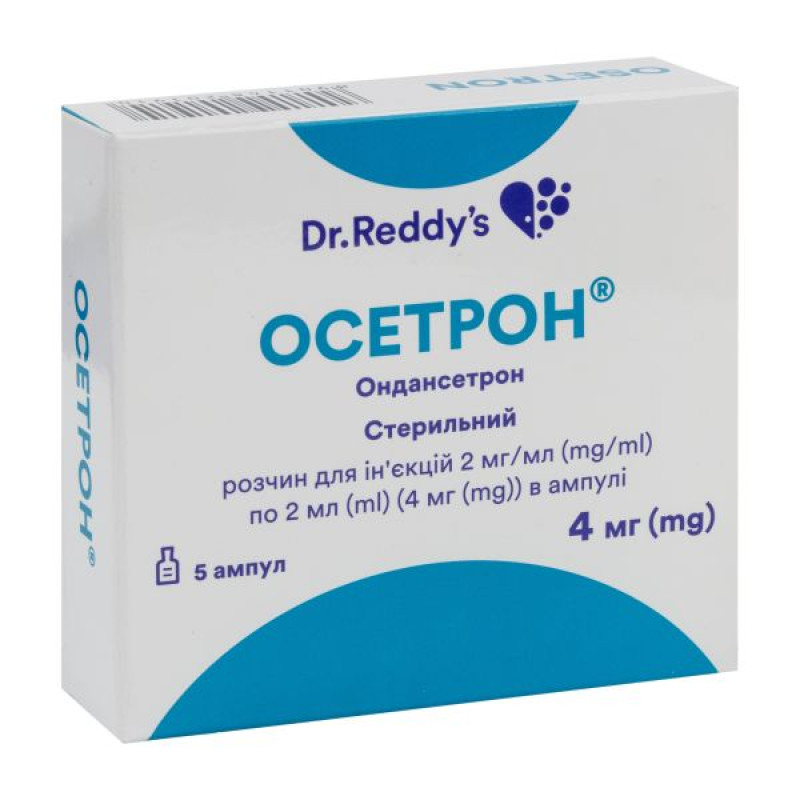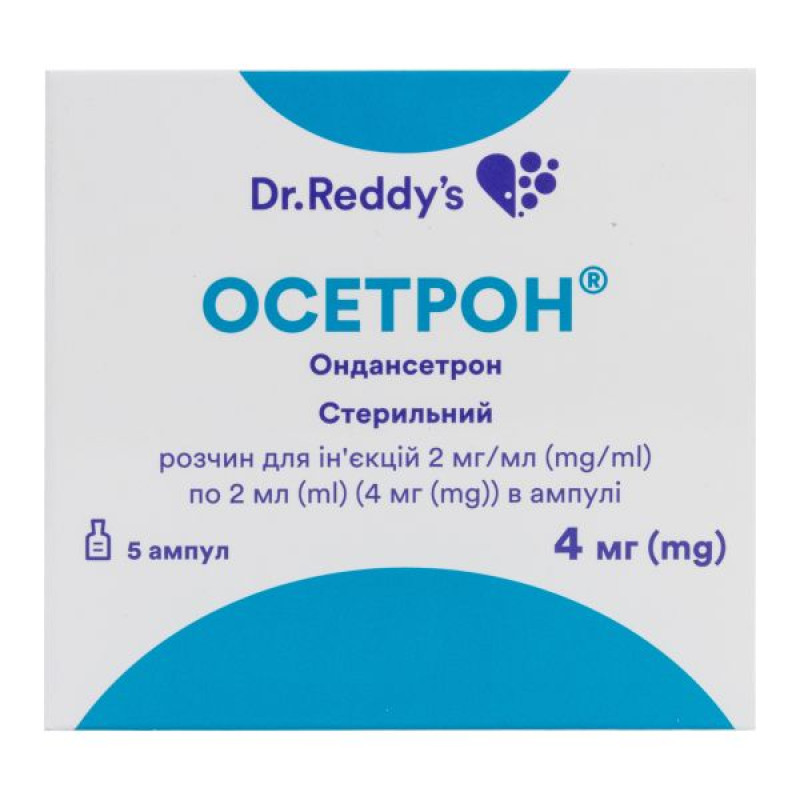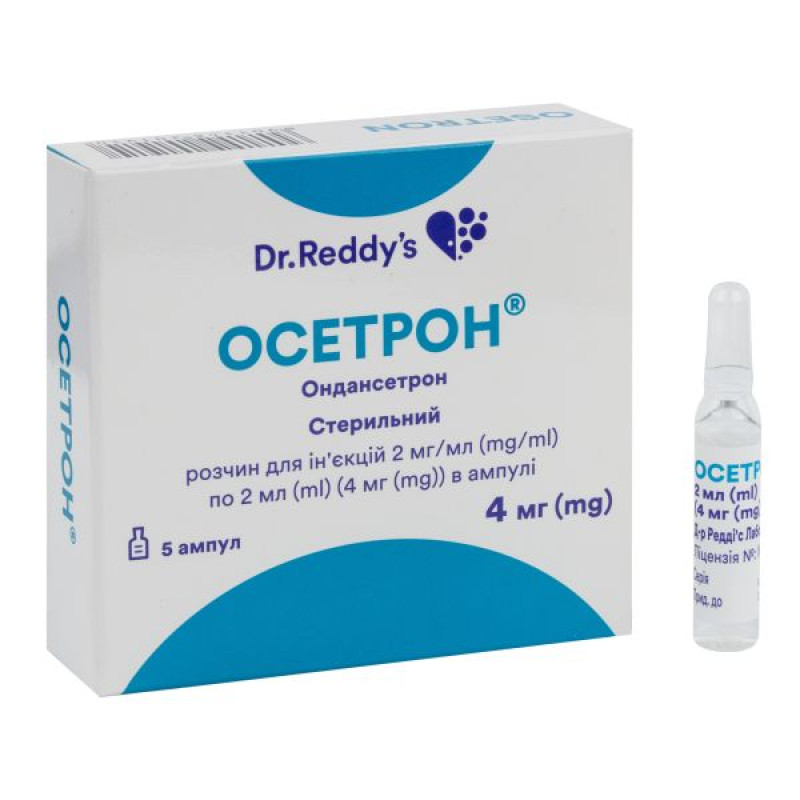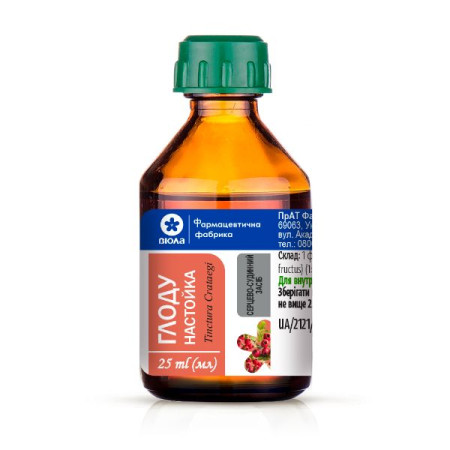Osetron solution for injection 4 mg ampoule 2 ml No. 5

Instructions Osetron solution for injection 4 mg ampoule 2 ml No. 5
Composition
active ingredient: ondansetron;
1 ml of solution contains ondansetron hydrochloride equivalent to 2 mg of ondansetron;
Excipients: citric acid monohydrate; sodium citrate; sodium chloride; water for injections.
Dosage form
Solution for injection.
Main physicochemical properties: clear, colorless solution, practically free from particles.
Pharmacotherapeutic group
Antiemetics and antinausea drugs. Serotonin 5HT3 receptor antagonists. ATC code A04A A01.
Pharmacological properties
Pharmacodynamics. Ondansetron is an antiemetic from the group of serotonin antagonists. Serotonin 5-HT3 receptors are located on vagal afferent fibers of the peripheral nervous system, as well as in chemoreceptors of the trigger zone area postrema.
Chemotherapy and radiotherapy promote the release of 5HT (serotonin) from enterochromaffin cells of the small intestine and provoke the vomiting reflex by stimulating 5-HT3 receptors of afferent fibers. Ondansetron blocks the development of these reflexes and may additionally affect 5-HT3 receptors of the central nervous system by affecting the vagal zones of the area postrema. Thus, in cytotoxic chemotherapy and radiotherapy, the action of ondansetron is due to antagonism of 5-HT3 receptors of neurons of the peripheral and central nervous system. The drug has anxiolytic activity, does not cause impaired coordination of movements or a decrease in activity and performance.
Pharmacokinetics. When administered intravenously, the drug is rapidly distributed with the bloodstream to all organs and tissues of the body. The maximum concentration of ondansetron in the blood is achieved after intravenous infusion of 4 mg after 5 minutes and within 10 minutes after intramuscular injection. Binding to plasma proteins is high (70–76%). Ondansetron is mainly eliminated from the systemic circulation by hepatic metabolism, at least 5% of the dose is excreted in the urine unchanged. The average half-life in adult patients is approximately 3 hours. In case of impaired liver function, an increase in the half-life to 15–20 hours is noted. It is actively metabolized in the body, metabolites are excreted in feces and urine.
Indication
Nausea and vomiting induced by cytotoxic chemotherapy and radiotherapy. Prevention and treatment of postoperative nausea and vomiting.
Contraindication
Hypersensitivity to ondansetron or to any of the other ingredients of the drug. The use of ondansetron with apomorphine hydrochloride is contraindicated, as cases of pronounced arterial hypotension and loss of consciousness have been observed during concomitant use.
Interaction with other medicinal products and other types of interactions
Ondansetron does not accelerate or inhibit the metabolism of other drugs when used simultaneously with it. Special studies have shown that ondansetron does not interact with alcohol, temazepam, furosemide, alfentanil, tramadol, morphine, lignocaine, thiopental or propofol.
Ondansetron is metabolized by various hepatic cytochrome P450 enzymes: CYP3A4, CYP2D6 and CYP1A2. Due to the diversity of ondansetron metabolizing enzymes, inhibition or reduction of the activity of one of them (e.g. genetic deficiency of CYP2D6) is normally compensated by the other enzymes and will have no or negligible effect on total creatinine clearance.
Ondansetron should be used with caution in combination with drugs that prolong the QT interval and/or cause electrolyte imbalance (see section "Special warnings and precautions for use").
The use of ondansetron with drugs that prolong the QT interval may lead to additional prolongation of the QT interval. Concomitant use of ondansetron with cardiotoxic drugs (e.g. anthracyclines such as doxorubicin, daunorubicin, or trastuzumab), antibiotics (such as erythromycin), antifungal drugs (such as ketoconazole), antiarrhythmic drugs (such as amiodarone), and beta-blockers (such as atenolol or timolol) increases the risk of arrhythmias (see section "Special instructions").
Serotonergics (e.g., SSRIs and SNRIs)
Serotonin syndrome (including mental status changes, autonomic instability and neuromuscular disorders) has been described following concomitant use of ondansetron and other serotonergic drugs, including selective serotonin reuptake inhibitors (SSRIs) and serotonin-norepinephrine reuptake inhibitors (SNRIs) (see section 4.4).
Apomorphine
The use of ondansetron with apomorphine hydrochloride is contraindicated, as cases of marked hypotension and loss of consciousness have been observed during concomitant use.
Phenytoin, carbamazepine, and rifampicin
In patients treated with potent CYP3A4 inducers (e.g. phenytoin, carbamazepine and rifampicin), the clearance of ondansetron is increased and its blood concentration is decreased.
Tramadol
According to some clinical studies, ondansetron may reduce the analgesic effect of tramadol.
Application features
Hypersensitivity reactions have been observed in patients with hypersensitivity to other selective 5HT3 receptor antagonists.
Respiratory reactions are treated symptomatically. Healthcare professionals should pay special attention to them as they are signs of drug hypersensitivity reactions.
Ondansetron prolongs the QT interval in a dose-dependent manner (see section 5.1). In addition, cases of ventricular fibrillation/flutter (torsade de pointes) have been reported in post-marketing experience with ondansetron. Ondansetron should be avoided in patients with congenital long QT syndrome. Ondansetron should be used with caution in patients who have or may develop QT prolongation, including patients with electrolyte imbalance, congestive heart failure, bradyarrhythmias, and patients receiving other drugs that may prolong the QT interval or electrolyte imbalance. Hypokalemia and hypomagnesemia should be corrected before starting treatment.
Myocardial ischemia has been reported in patients receiving ondansetron. In some patients, especially when administered intravenously, symptoms have occurred immediately after administration of ondansetron. Patients should be advised of the signs and symptoms of myocardial ischemia.
Serotonin syndrome has been described following concomitant use of ondansetron and other serotonergic drugs (see section 4.5). If concomitant treatment with ondansetron and other serotonergic drugs is clinically warranted, appropriate monitoring of the patient is recommended.
Since ondansetron weakens intestinal peristalsis, careful monitoring of patients with signs of subacute intestinal obstruction is required during the use of the drug Osetron®.
In patients undergoing adenotonsillar surgery, the use of ondansetron for the prevention of nausea and vomiting may mask the occurrence of bleeding. Therefore, such patients should be carefully monitored after the use of ondansetron.
This medicinal product contains less than 1 mmol (23 mg) sodium/dose, i.e. essentially 'sodium-free'.
Children
Children receiving ondansetron with hepatotoxic chemotherapeutic agents should be closely monitored for possible liver dysfunction.
Dosage regimens
When calculating the dose according to body weight and using three doses at 4-hour intervals, the total daily dose will be higher than when using a single dose of 5 mg/m2 and a single oral dose. The comparative efficacy of these two dosing regimens has not been evaluated in clinical trials. Comparison of the results of different studies indicates similar efficacy of both dosing regimens.
Use during pregnancy or breastfeeding
Women of childbearing potential: If ondansetron is used in women of childbearing potential, the use of contraception should be considered.
Pregnancy: Based on human experience in epidemiological studies, there is suspicion of the development of maxillofacial defects when ondansetron is used during the first trimester of pregnancy.
In one cohort study involving 1.8 million pregnancies, ondansetron use during the first trimester of pregnancy was associated with an increased risk of oral clefts [3 additional cases per 10,000 women treated with ondansetron; adjusted relative risk: 1.24 (95% confidence interval (CI) 1.03–1.48)]. Available epidemiological data on cardiac malformations show conflicting results. Animal studies do not indicate direct or indirect harmful effects with respect to reproductive function.
Ondansetron should not be used during the first trimester of pregnancy.
Breastfeeding: In experimental studies, it has been shown that ondansetron passes into breast milk in animals. If necessary, the use of the drug should be discontinued during breastfeeding.
Fertility: There is no information on the effect of ondansetron on human fertility.
The ability to influence the reaction speed when driving or working with other mechanisms
Psychomotor tests have shown that ondansetron does not affect the ability to drive or use machines and does not cause sedation. However, the adverse reaction profile of the drug should be taken into account when deciding whether to drive or use machines.
Method of administration and doses
Nausea and vomiting caused by chemotherapy and radiation therapy.
Adults.
The emetogenic potential of cancer therapy varies depending on the dose and combination of chemotherapy and radiotherapy regimens. The choice of dosing regimen depends on the severity of the emetogenic effect.
Emetogenic chemotherapy and radiation therapy.
For the prevention of delayed or prolonged vomiting after the first 24 hours, oral or rectal administration of the drug is recommended.
Highly emetogenic chemotherapy (e.g. high doses of cisplatin).
Osetron® can be administered as a single dose of 8 mg, intravenously or intramuscularly immediately before chemotherapy.
For highly emetogenic chemotherapy, 8 mg ondansetron or a lower dose does not require dilution and can be administered by slow intravenous or intramuscular injection (at least 30 seconds) immediately before chemotherapy, followed by two intravenous or intramuscular injections of 8 mg at 2 and 4 hours, or by continuous infusion of 1 mg/h for 24 hours.
Doses above 8 mg (up to 16 mg) should only be administered as an intravenous infusion in 50–100 ml of 0.9% sodium chloride solution or other suitable diluent (see below “Using the injection solution”); the infusion should last at least 15 minutes.
A single dose greater than 16 mg should not be used (see section "Special precautions for use").
The efficacy of ondansetron in highly emetogenic chemotherapy may be enhanced by additional single intravenous administration of dexamethasone sodium phosphate at a dose of 20 mg before chemotherapy.
For the prevention of delayed or prolonged vomiting after the first 24 hours, oral or rectal administration of the drug is recommended.
Children aged 6 months to 17 years
The dose of the drug can be calculated based on the child's body surface area or body weight.
Dose calculation according to the child's body surface area
Osetron® should be administered immediately before chemotherapy by a single intravenous injection at a dose of 5 mg/m², the intravenous dose should not exceed 8 mg. After 12 hours, oral administration of the drug can be started, which can continue for another 5 days. Do not exceed the adult dose.
Dose calculation according to the child's body weight
Osetron® should be administered immediately before chemotherapy by a single intravenous injection at a dose of 0.15 mg/kg. The intravenous dose should not exceed 8 mg. On the first day, 2 more intravenous doses can be administered at 4-hour intervals. After 12 hours, oral administration of the drug can be started, which can continue for another 5 days. Do not exceed the adult dose.
Elderly patients
For patients aged 65 years and older, all doses for intravenous injections should be dissolved and administered within 15 minutes; with repeated administration, the interval between injections should be at least 4 hours.
For patients aged 65 to 74 years, the initial dose of ondansetron is 8 mg or 16 mg, which should be administered by intravenous infusion over 15 minutes, which can be continued by administering 2 doses of 8 mg over 15 minutes with an interval between infusions of at least 4 hours.
For patients aged 75 years and older, the initial intravenous dose of ondansetron should not exceed 8 mg infused over at least 15 minutes. After an initial dose of 8 mg, administration may be continued with 2 doses of 8 mg, which should be infused over 15 minutes with an interval of at least 4 hours between infusions.
Patients with renal insufficiency
There is no need to change the dosage regimen or route of administration in patients with renal impairment.
Patients with hepatic insufficiency
In patients with moderate to severe hepatic impairment, the clearance of ondansetron is significantly reduced and the serum half-life is prolonged. For such patients, the maximum daily dose should not exceed 8 mg.
Patients with impaired metabolism of sparteine/debrisoquine
The half-life of ondansetron in patients with impaired metabolism of sparteine and debrisoquine is not altered. In such patients, after repeated administration, the drug concentration is the same as in patients with intact metabolism. Therefore, a change in dosage or frequency of administration is not required.
Postoperative nausea and vomiting.
Adults.
For the prevention of postoperative nausea and vomiting, the recommended dose of ondansetron is 4 mg as a single intramuscular or slow intravenous injection during induction of anesthesia.
For the treatment of postoperative nausea and vomiting, the recommended single dose of ondansetron is 4 mg as an intramuscular or slow intravenous injection.
Children aged 1 month to 17 years
For the prevention and treatment of postoperative nausea and vomiting in children undergoing surgery under general anesthesia, ondansetron can be administered at a dose of 0.1 mg/kg body weight (maximum - up to 4 mg) by slow intravenous injection (not less than 30 seconds) before, during, after induction of anesthesia or after surgery.
Elderly patients
Experience with the use of ondansetron for the prevention and treatment of postoperative nausea and vomiting in the elderly is limited, however, ondansetron is well tolerated in patients aged 65 years and older receiving chemotherapy.
Patients with renal insufficiency
There is no need to change the dosage regimen or route of administration in patients with renal impairment.
Patients with hepatic insufficiency
In patients with moderate to severe hepatic impairment, the clearance of ondansetron is significantly reduced and the serum half-life is prolonged. For such patients, the maximum daily dose should not exceed 8 mg.
The half-life of ondansetron in patients with impaired metabolism of sparteine and debrisoquine is not altered. In such patients, repeated administration results in the same drug concentration as in patients with intact metabolism. Therefore, no change in dosage or frequency of administration is necessary.
Use of injection solution
The medicinal product does not contain preservatives and the solution should be used immediately after opening the ampoule; any remaining solution should be discarded.
Ampoules with the drug cannot be autoclaved.
Compatibility with other intravenous fluids
Intravenous solutions should be prepared immediately before infusion. However, ondansetron solution has been shown to be stable for 7 days at room temperature (up to 25°C) in daylight or in a refrigerator when dissolved in the following media: 0.9% sodium chloride solution, 5% glucose solution, 10% mannitol solution, Ringer's solution, 0.3% potassium chloride solution and 0.9% sodium chloride solution, 0.3% potassium chloride solution and 5% glucose solution.
Ondansetron has been shown to be stable in polyethylene and glass vials. Ondansetron has been shown to be stable in polypropylene syringes when diluted with 0.9% sodium chloride or 5% glucose. Stability in polypropylene syringes has also been shown to be stable when diluted with other recommended solutions.
If long-term storage of the drug is necessary, dissolution should be carried out under appropriate aseptic conditions.
Compatibility with other drugs
Osetron® can be administered as an intravenous infusion at a rate of 1 mg/h. Via a Y-injector together with the drug at an ondansetron concentration of 16 to 160 μg/ml (i.e. 8 mg/500 ml or 8 mg/50 ml respectively) the following can be administered:
cisplatin at a concentration of up to 0.48 mg/ml, for 1–8 hours;
5-fluorouracil at a concentration of up to 0.8 mg/ml (e.g. 2.4 g in 3 L or 400 mg in 500 ml) at a rate not exceeding 20 ml/h. Higher concentrations of 5-fluorouracil may cause precipitation of ondansetron. 5-fluorouracil infusion solution may contain up to 0.045% magnesium chloride in addition to other compatible excipients;
carboplatin at a concentration of 0.18 mg/ml to 9.9 mg/ml (e.g. 90 mg in 500 ml to 990 mg in 100 ml) over 10–60 minutes;
etoposide at a concentration of 0.14 mg/ml to 0.25 mg/ml (e.g. 72 mg in 500 ml to 250 mg in 1 l) over 30–60 minutes;
ceftazidime at a dose of 250 mg to 2 g, diluted in water for injection (e.g. 2.5 ml for 250 mg or 10 ml for 2 g of ceftazidime) as an intravenous bolus injection over 5 minutes;
cyclophosphamide in a dose of 100 mg to 1 g, diluted in water for injection (5 ml per 100 mg of cyclophosphamide), as an intravenous bolus injection over 5 minutes;
doxorubicin at a dose of 10 mg to 100 mg, diluted in water for injection (5 ml per 10 mg of doxorubicin), as an intravenous bolus injection over 5 minutes;
dexamethasone at a dose of 20 mg, as a slow intravenous injection over 2–5 minutes (with simultaneous administration of 8 mg or 16 mg of ondansetron dissolved in 50–100 ml of injection solution), for about 15 minutes. Since these drugs are compatible, they can be administered through a single dropper, while in the solution the concentrations of dexamethasone phosphate (in the form of the sodium salt) will be from 32 μg to 2.5 mg per 1 ml, and ondansetron - from 8 μg to 1 mg per 1 ml.
Children. Use in children from 6 months of age (for chemotherapy) and from 1 month of age (for prevention and treatment of postoperative nausea and vomiting).
Overdose
There is limited information on overdose with ondansetron. In most cases, the symptoms are similar to those described in patients given the recommended doses (see section 4.8).
Manifestations of overdose such as visual disturbances, severe constipation, hypotension, vasovagal manifestations with transient second-degree atrioventricular block have been reported. In all cases, these phenomena resolved completely.
Ondansetron prolongs the QT interval in a dose-dependent manner. ECG monitoring is recommended in case of overdose.
There is no specific antidote, therefore, in case of overdose, symptomatic and supportive therapy should be used.
The use of ipecacuanha to treat ondansetron overdose is not recommended because its effect may not be due to the antiemetic effects of the drug.
Children: Serotonin syndrome has been reported in infants and children aged 12 months to 2 years following accidental overdose of the oral preparation (doses exceeding the recommended level of 4 mg/kg).
Side effects
Adverse reactions are classified by system organ class and by frequency of occurrence. Adverse reactions are classified by frequency of occurrence into the following categories: very common (≥1/10), common (≥1/100 and <1/10), uncommon (≥1/1000 and <1/100), rare (≥1/10,000 and <1/1000), very rare (<1/10,000).
On the part of the immune system
Rare: immediate hypersensitivity reactions, sometimes severe, up to anaphylaxis.
From the nervous system
Very common: headache.
Uncommon: convulsions, movement disorders (including extrapyramidal reactions such as oculogyric crisis, dystonic reactions and dyskinesia without lasting clinical consequences).
Rare: dizziness, mainly during rapid intravenous administration of the drug.
Rare: transient visual disturbances (clouding of the eyes), mainly during intravenous administration.
Very rare: transient blindness, mainly during intravenous administration. In most cases, blindness resolves within 20 minutes. Most patients received chemotherapy drugs that included cisplatin. Some cases of transient blindness have been reported as blindness of cortical origin.
From the heart
Uncommon: arrhythmias, chest pain (with or without ST segment depression), bradycardia.
Rare: QT prolongation, including ventricular fibrillation/flutter (torsade de pointes).
Myocardial ischemia (frequency unknown) (see section "Special warnings and precautions for use").
From the vascular side
Common: feeling warm or flushed.
Uncommon: hypotension.
Respiratory and thoracic disorders
Uncommon: hiccups.
From the digestive tract:
Common: constipation.
Hepatobiliary system
Uncommon: asymptomatic elevation of liver function tests.
These cases are observed mainly in patients treated with chemotherapy drugs containing cisplatin.
Skin and subcutaneous tissue disorders
Very rare: toxic rashes, including toxic epidermal necrolysis.
General disorders
Common: reactions at the intravenous injection site.
The following adverse reactions have been reported during post-marketing surveillance.
Cardiovascular system: chest pain and discomfort, extrasystoles, tachycardia, including ventricular and supraventricular tachycardia, atrial fibrillation, palpitations, syncope, ECG changes.
Hypersensitivity reactions: anaphylactic reactions, angioedema, bronchospasm, anaphylactic shock, itching, skin rash, urticaria.
Nervous system disorders: gait disturbance, chorea, myoclonus, restlessness, burning sensation, tongue protrusion, diplopia, paresthesia.
General disorders and local reactions: fever, pain, redness, burning at the injection site.
Other: hypokalemia.
Expiration date
3 years.
Storage conditions
Store at a temperature not exceeding 25 °C in the original packaging, out of the reach of children. Do not freeze.
Incompatibility
Osetron® should not be used in the same syringe or infusion solution with other drugs. Osetron® in the form of injections can only be combined with recommended infusion solutions (see section "Method of administration and dosage").
Packaging
2 ml (4 mg) or 4 ml (8 mg) in an ampoule, 5 ampoules in a blister, 1 blister in a cardboard box.
Vacation category
According to the recipe.
Producer
Dr. Reddy's Laboratories Limited
Location of the manufacturer and its business address.
Production site - VI Village Khol, Nalagar Road, Baddi, Solan District, Himachal Pradesh, 173205, India
You can report an adverse reaction or lack of effectiveness when using a medicine by calling:
+380 44 207 51 97 or +380 50 414 39 39; and also by email: DrugSafetyUa@drreddys.com (24/7).
There are no reviews for this product.
There are no reviews for this product, be the first to leave your review.
No questions about this product, be the first and ask your question.












